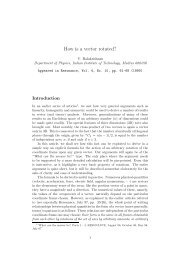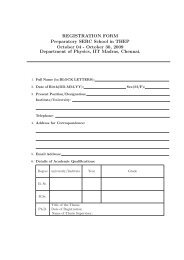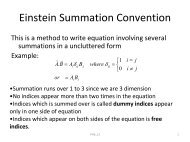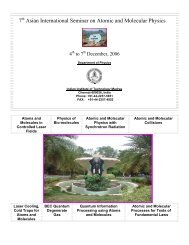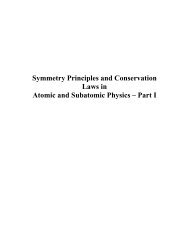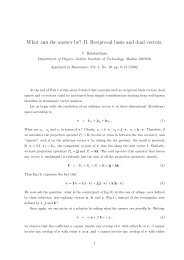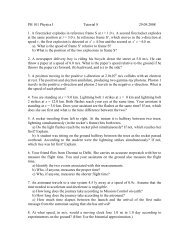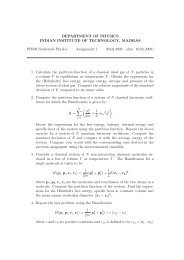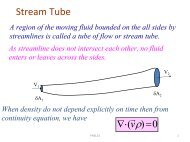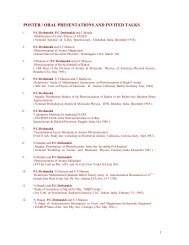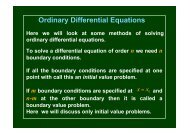Techniques in oscillatory shear rheology - Indian Institute of ...
Techniques in oscillatory shear rheology - Indian Institute of ...
Techniques in oscillatory shear rheology - Indian Institute of ...
You also want an ePaper? Increase the reach of your titles
YUMPU automatically turns print PDFs into web optimized ePapers that Google loves.
<strong>Techniques</strong> <strong>in</strong> <strong>oscillatory</strong> <strong>shear</strong> <strong>rheology</strong> 9L<strong>in</strong>ear response is usually very important <strong>in</strong> understand<strong>in</strong>g basic mechanismsresponsible for material behaviour. Nonl<strong>in</strong>ear response, on the other hand, is morerelevant for applications and is also more difficult to characterize. Measur<strong>in</strong>g thenonl<strong>in</strong>ear response <strong>of</strong> a material to an excitation is a way to exam<strong>in</strong>e properties,which cannot be characterized by exam<strong>in</strong><strong>in</strong>g the l<strong>in</strong>ear response. Understand<strong>in</strong>gnonl<strong>in</strong>ear effects has led to breakthroughs <strong>in</strong> different materials such as elastic,plastic, viscoelastic, optical materials, ferroelectric, freez<strong>in</strong>g, or dipolar glass transitions,isotropic-liquid crystal transition or b<strong>in</strong>ary mixtures, superconductivity, fieldor heat<strong>in</strong>g effects <strong>in</strong> electrical transport, heat<strong>in</strong>g due to electric field excitation <strong>of</strong>supercooled liquids [24].Similar techniques are used for the analysis <strong>of</strong> nonl<strong>in</strong>ear response <strong>in</strong> these diverseareas. As an example, the response <strong>in</strong> dielectric spectroscopy and mechanical spectroscopycan be understood <strong>in</strong> relation to each other. For small amplitude <strong>of</strong> electricfield, similar to Eq. 7, we can write the relation between electric displacement (D)and electric field (E) as,D = ε ∗ E , (16)where ε ∗ is permittivity <strong>of</strong> material. The modes <strong>of</strong> material response, as discussed<strong>in</strong> earlier sections, can also be identified by exam<strong>in</strong><strong>in</strong>g the dielectric response as afunction <strong>of</strong> frequency. In case <strong>of</strong> <strong>rheology</strong>, load and displacement are measured andanalysis is carried out for stress, stra<strong>in</strong> or stra<strong>in</strong> rate. In case <strong>of</strong> dielectric response,we measure current and voltage and carry out the analysis with electric field, polarisationor electric displacement.When material is subjected to large amplitude <strong>of</strong> electric field, the above equationis no longer valid. However, material behaviour can be described by writ<strong>in</strong>g higherorder terms <strong>in</strong> electric field [3],D = ε ∗ 1 E + ε ∗ 2 E 2 + ε ∗ 3 E 3 +... , (17)where ε n is the permittivity <strong>of</strong> n th order. It can be shown that only the odd poweredterms <strong>of</strong> the above equation are non-zero. In addition to such general descriptions,variety <strong>of</strong> theoretical and experimental tools are common <strong>in</strong> <strong>in</strong>vestigations <strong>of</strong>nonl<strong>in</strong>ear response <strong>of</strong> materials. In the next few sections, various features <strong>of</strong> nonl<strong>in</strong>earresponse <strong>in</strong> <strong>oscillatory</strong> <strong>shear</strong> will be described.2 Oscillatory test<strong>in</strong>g at large amplitudeThe classes <strong>of</strong> overall <strong>oscillatory</strong> rheological response <strong>of</strong> materials can be understoodfrom the diagram shown <strong>in</strong> Fig. 4. The diagram (referred to as Pipk<strong>in</strong> diagram)can be recast <strong>in</strong> the form <strong>of</strong> dimensionless numbers, Weissenberg number(We = ˙γλ) and Deborah number (De = ωλ). At low frequencies, and at lowstra<strong>in</strong> amplitudes, the material response is purely viscous and Newtonian. As mentionedearlier, this is at timescales larger than the largest relaxation time <strong>in</strong> the ma-



